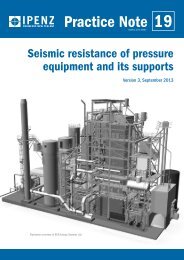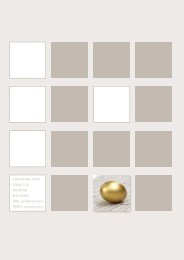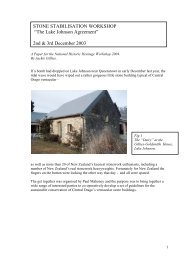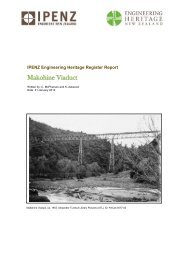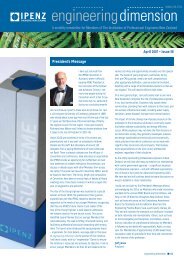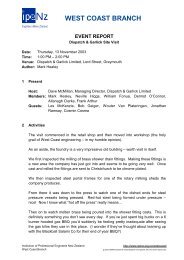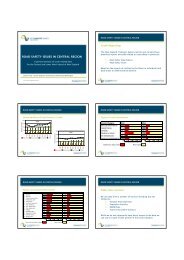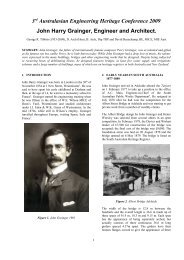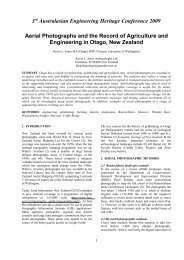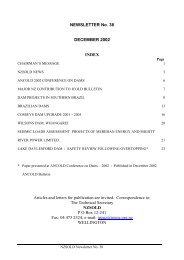Karori Water Supply Dams and Reservoirs Register Report - ipenz
Karori Water Supply Dams and Reservoirs Register Report - ipenz
Karori Water Supply Dams and Reservoirs Register Report - ipenz
You also want an ePaper? Increase the reach of your titles
YUMPU automatically turns print PDFs into web optimized ePapers that Google loves.
shovels. It seems that this digging was a greater task than anticipated, with poor<br />
quality rock forcing the men to go deeper to find a good foundation for the dam. 36<br />
Morton was happy with the way the dam turned out upon its completion in March<br />
1908. Morton stated that:<br />
<strong>Water</strong> was looked upon by engineers <strong>and</strong> contractors as an insidious enemy,<br />
still there were thirty-five feet of water already in the new reservoir, <strong>and</strong> he<br />
had not been able to trace the slightest degree of soakage. He believed that<br />
the work would prove perfectly satisfactory. 37<br />
The dam was formally opened on 29 November 1908. 38 Like the Waitakere Dam<br />
completed two years later, the Upper <strong>Karori</strong> Dam was lauded as a major New<br />
Zeal<strong>and</strong> engineering feat of the time. 39<br />
Dry summers during World War One soon put pressure on the Council to again<br />
exp<strong>and</strong> its water supply infrastructure. Therefore, Morton looked to the Orongorongo<br />
catchment, further northeast of the Wainuiomata reservoir. Rather than create a dam<br />
<strong>and</strong> reservoir, a weir was built <strong>and</strong> the water was piped to the Lower <strong>Karori</strong> reservoir<br />
<strong>and</strong> distributed from there. 40<br />
In the 1930s there seems to a have been a constant effort by Wellington‟s heavily in<br />
debt <strong>Water</strong> <strong>Supply</strong> Board to locate <strong>and</strong> tap into good water sources around the region<br />
for central Wellington <strong>and</strong> its exp<strong>and</strong>ing suburbs. The Hutt River was a likely source,<br />
although the water quality was variable. A further Wainuiomata dam was also<br />
proposed, as was exploitation of the Hutt aquifer. Much negotiating with the Petone<br />
<strong>and</strong> Hutt Borough Councils eventually led to the <strong>Water</strong> <strong>Supply</strong> Board building a<br />
pumping station at Gear Isl<strong>and</strong>, Petone, completed in 1935. This drew water from the<br />
Waiwhetu aquifer <strong>and</strong> linked into the Orongorongo to <strong>Karori</strong> water main. In the<br />
meantime a chlorination plant <strong>and</strong> pump station were built at <strong>Karori</strong>. However, the<br />
36 Emma Meyer, „Registration <strong>Report</strong> for a Historic Place: Upper <strong>Karori</strong> Dam,‟ New Zeal<strong>and</strong> Historic Places Trust, 1<br />
May 2008, pp.7-9<br />
37 „The New Reservoir‟<br />
38 Meyer, p.17<br />
39 Offer, 1997, p.64<br />
40 Cooke, 2007, p.16<br />
IPENZ Engineering Heritage <strong>Report</strong> 12<br />
<strong>Karori</strong> <strong>Water</strong> <strong>Supply</strong> <strong>Dams</strong> <strong>and</strong> <strong>Reservoirs</strong>



